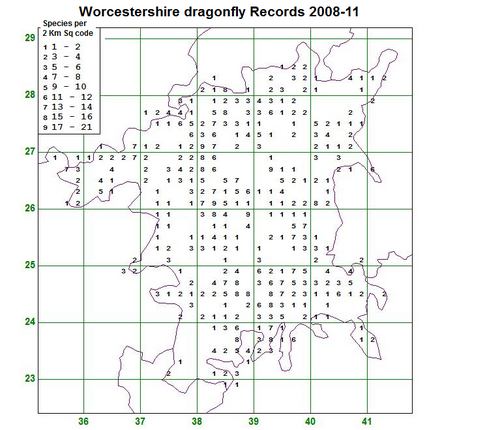The new Dragonfly Atlas of England, Wales & Scotland
Mike Averill
This is the last year left to survey for the National Dragonfly Atlas and there is still time to visit those remote corners of Worcestershire. 2011 was the fourth of the five year project to remap the dragonflies in the UK mainland. In Worcestershire 86 recorders gathered 1312 new records which added to the previous three years to give 4588 in total (Table 1).
Table 1. Totals of records of dragonfly species in Worcestershire
| 2008 | 1107 |
| 2009 | 1172 |
| 2010 | 997 |
| 2011 | 1312 |
| Total | 4588 |
The main reason to re-survey is that the last major Atlas was published in 1990 and there have been considerable changes since then both in numbers of new species and their distribution. In that time Worcestershire has seen five new species including Yellow-winged Darter Sympetrum flaveolum; Red-veined Darter Sympetrum fonscolombii; Scarce Chaser Libellula fulva; Lesser Emperor Anax parthenope and Small Red-eyed damselfly Erythromma viridulum.
The results from the last four years in Worcestershire are summarised in the map (Fig. 1.) which shows how many species have been recorded in each 2×2 km square. The total is coded into nine groups as shown in the key. The map shows that many squares still only have two species or less recorded which hopefully can be rectified in 2012. There are a few sites coded to nine which means that there are between 17 and 21 species present as at the Grimley gravel pits and Upton Warren, but if possible recording in the blank areas is needed as the popular sites are well covered.
In 2011 new records helped to fill in some of the outlying areas around Tenbury Wells, but there are still large gaps in quite a few locations such as in the SW, SE and NE of the county.
Please send your records to mike.averill@blueyonder.co.uk and these should contain at least the basic information about the location of the dragonfly with grid reference, date, and species, but if you can give any estimate of numbers or breeding activity that would add a lot to the record. If you feel keen I can send a spreadsheet with a pick list of species already entered.
For details of the individual species records and where to record, you will be able to visit a new website dedicated to Worcestershire Dragonflies before the start of the new season.
If you are outside Worcestershire on holiday, don’t forget it is a national atlas. All records are welcome and I am happy to receive them all or you can enter them online via the British Dragonfly Society website: http://british-dragonflies.org.uk/content/submit-records.
Records from Herefordshire are also badly needed to bring the dataset up to date.
Image
Fig. 1. Dragonflies recorded in Worcestershire 2008-11
